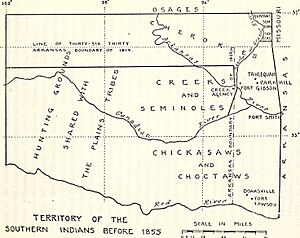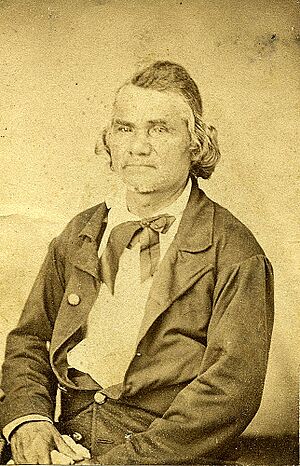Doaksville, Choctaw Nation facts for kids
Doaksville was once a busy town, but now it's a ghost town in what is today Choctaw County, Oklahoma. It was started between 1824 and 1831 by people from the Choctaw Indian tribe. They were forced to leave their homes in the southeastern United States and move to a new area called Indian Territory. The town was named after Josiah Stuart Doak, who owned a trading post there. Doaksville grew and did well until the U.S. Army left a nearby fort in 1854. It was even the capital city for the Choctaw Nation for a while. But after a new railroad was built far away from the town in 1870, Doaksville quickly became empty. Today, it is a ghost town and a place where archaeologists study the past.
Contents
Doaksville's Early History
Doaksville was an important town for the Choctaw Nation in the Indian Territory. This was because it was easy to reach by steamboat on the Red River. In the 1820s and 1830s, many Choctaw people who had to move from their homes came to Doaksville. Josiah Doak and his brother first set up their trading post near the Kiamichi River. Later, they moved it about a mile west of the Fort Towson-Doaksville Cemetery. This move happened after the U.S. Army built Fort Towson in 1824. The town of Doaksville started to grow a lot in 1831. This was when the Army reopened Fort Towson nearby.
Important Treaties and Town Life
In 1837, the Chickasaw and Choctaw people signed an important agreement called the Treaty of Doaksville. This treaty allowed the Chickasaw Nation to rent the western part of the Choctaw Nation's land. They used this land for their own settlements.
By 1840, Doaksville was a busy place. It had several stores, a mill for grinding grain, a blacksmith shop, and a hotel. In 1842, William Armstrong, who worked with the Choctaw people, wrote about how special the town was. He said it was one of the most peaceful towns in the west. He noted it had a doctor, a good hotel, and shops for blacksmiths and wagon makers. He also mentioned that a church had been built. A group that encouraged people to live healthy lives was also formed. This group included many respected Choctaw and Chickasaw people. A post office, where people could send and receive mail, opened in Doaksville in 1847.
Doaksville as a Capital City
By 1850, Doaksville had become the largest town in Indian Territory. It had more than thirty buildings. There were even two newspapers, and at least one of them, the Choctaw Intelligencer, was printed in the Choctaw language. In 1855, the Choctaw and Chickasaw Nations officially became separate. Doaksville then served as the capital city of the Choctaw Nation from 1860 to 1863. In 1860, a meeting in Doaksville approved the Doaksville Constitution. This document guided the Choctaw Nation until 1906. The capital later moved to Mayhew Mission in 1859, and then to Chahta Tamaha in 1863. Doaksville began to lose its importance in 1854, when the U.S. Army left Fort Towson.
The End of Doaksville
Confederate General Stand Watie officially ended his command at Doaksville on June 23, 1865. This happened after the American Civil War. After the war, Doaksville's economy suffered. The war had damaged the farming system in the area. In 1870, a new railroad line was built, but it did not go through Doaksville. Because of this, most businesses moved to the town of Fort Towson, which was on the rail line. Some say the town completely disappeared during the 1890s. The post office closed in 1903. Today, nothing is left of the town except for its cemetery.
Doaksville Today
The Oklahoma Historical Society bought the Doaksville site in 1960. They supported archaeological digs there during the 1990s. Today, it is a site where old things are protected and studied. In 2001, a walkway and signs were put in place. This allows visitors to see the foundations of old buildings. They can also see many artifacts that were found during digs in 1995, 1996, and 1997.
A place known as the Doaksville Site (NRID = 75001561) in Fort Towson, Oklahoma, was added to the National Register of Historic Places on May 29, 1975.
Images for kids





